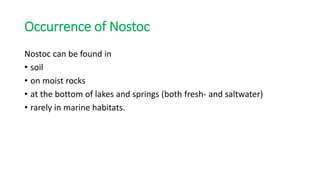Nostoc
- 1. Algae:Nostoc Prepared by: Md. Shakiur Rahman ID: 170711 Biotechnology and Genetic Engineering Discipline Khulna University,Bangladesh.
- 2. Morphology of Nostoc : • Thalli are present in the form of colony. • Ball like colony is enveloped by a gelatinous sheath. • Balls are greenish to bluish-green in colour. • Each colony contains thousands of straight or twisted filaments or trichomes. • Each trichome is surrounded by its individual sheath and called the filament. • A trichome is contorted and consists of many cells arranged in a beaded manner
- 3. • Each cell is somewhat cylindrical or spherical in shape. • In filaments there are present some large, spherical or cylindrical, colourless empty cells called hetero cysts. • Heterocysts are generally intercalary but in the young condition, they may be terminal. • Two polar nodules are present in each heterocyst. • Some cells of the filament become enlarged and filled with the food material. These thick-walled cells are called akinetes. • Akinetes are generally present in chain. Fig: A single filament of Nostoc
- 4. Fig: A. single vegetative cell B. HeterocystFig: A. Part of colony under low power B. Part of colony under high power
- 5. A Single Cell of Nostoc • Each cell is surrounded by a cellulose cell wall. • Protoplast shows the typical Myxophycean structure, i.e., inner colourless centroplasm and outer pigmented chromoplasm. • In the chromoplasm are present pigments, proteinaceous cyanophycin granules and cyanophycin starch granules • while in the centroplasm is present the incipient nucleus.
- 6. Occurrence of Nostoc Nostoc can be found in • soil • on moist rocks • at the bottom of lakes and springs (both fresh- and saltwater) • rarely in marine habitats.
- 7. Characteristics of Nostoc • Nostoc, genus of blue-green algae with cells arranged in beadlike chains that are grouped together in a gelatinous mass. • Size ranging from microscopic to walnut. • Masses of Nostoc may be found on soil and floating in quiet water. • Reproduction is by fragmentation. • A special thick-walled cell (akinete) has the ability to withstand desiccation for long periods of time. • After 70 years of dry storage, the akinete of one species germinates into a filament when moistened.
- 8. • Like most blue-green algae, Nostoc contains two pigments, blue phycocyanin and red phycoerythrin, as well as chlorophyll. • It has the ability to fix nitrogen in specialized cells called heterocysts. • A terrestrial species has been used as a supplementary food source in Asia.
- 9. Biotechnological Importance of Nostoc • Nostoc has been used as dietary supplements for centuries. • Several edible species (i.e., N. commune, N. sphaeroides, and N. flagelliforme) have been collected from various natural habitats for human use. • Recently, the nutritional value of the edible Nostoc species has been characterized and a number of pharmacological studies suggest that Nostoc contains a variety of bioactive compounds with the antitumor, antioxidant, or anti‐inflammatory functions. • To meet the increasing market demands, mass cultivation of Nostoc has been attempted during the past decades.
- 10. • Research on the morphological development, pharmaceutical values, growth, and physiology of Nostoc, with an emphasis on the edible species has been successfully done. • The edible species has been successfully cultivated at pilot scale, several technical challenges including the low growth rate, loss of colonies, and high cost of photobioreactors remain to be overcome for commercialization in the future.










